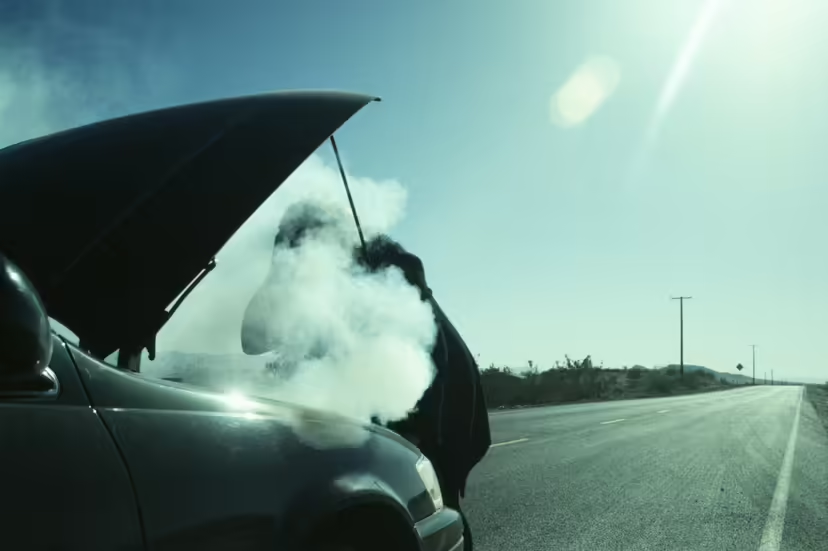Now Reading: white smoke from exhaust on startup then goes away
-
01
white smoke from exhaust on startup then goes away
white smoke from exhaust on startup then goes away

Starting your car and seeing a puff of smoke can be unsettling. If it’s white smoke from exhaust on startup then goes away, you might wonder if it signals a major problem. The good news is that it’s often harmless. However, understanding the potential causes can help you know when to relax and when to see a mechanic.
This guide will walk you through everything you need to know. We’ll explore why this happens, differentiate between normal condensation and signs of trouble, and explain what to do about it. By the end, you’ll be able to diagnose the situation with confidence.
Key Takeaways
- Thin, wispy white smoke that disappears quickly, especially in cold weather, is usually just water vapor (condensation) and is perfectly normal.
- Thick, persistent white smoke can indicate serious issues like a coolant leak from a blown head gasket or a cracked cylinder head.
- The color, smell, and thickness of the smoke are key indicators of the underlying cause.
- Regular maintenance, including checking fluid levels and monitoring your engine’s temperature, can help prevent major problems.
What Causes White Smoke From Exhaust on Startup Then Goes Away?
Seeing that puff of white smoke can be alarming, but don’t panic just yet. In most cases, especially on cooler days, this is a completely normal occurrence. The primary cause is condensation that has built up inside your exhaust system overnight.
When your car is parked, the exhaust cools down, and moisture from the air condenses into water droplets inside the pipes and muffler. When you start the engine, the hot exhaust gases rapidly heat this water, turning it into steam. This steam is the thin, white smoke you see coming from the tailpipe. Once the exhaust system fully heats up and all the collected water has evaporated, the smoke disappears. This process is similar to seeing your breath on a cold morning. It’s a natural physical reaction to temperature differences and is no cause for concern. You’ll notice it more frequently during fall and winter or on humid mornings.
Is It Just Condensation or Something More Serious?
Distinguishing between harmless condensation and a symptom of a real problem is crucial. The key lies in observing the smoke’s characteristics and how long it lasts.
Identifying Normal Condensation
- Appearance: The smoke is thin, wispy, and almost translucent, much like steam from a kettle.
- Duration: It only lasts for a few minutes after you start the car and vanishes once the engine reaches its normal operating temperature.
- Smell: There is no distinct smell other than a typical faint exhaust odor. It might smell slightly of water.
- Weather: It’s most common in cold or cool, damp weather.
Signs of a Bigger Problem
- Appearance: The smoke is thick, dense, and looks like a massive white cloud.
- Duration: It continues long after the engine has warmed up and may even get worse as you drive.
- Smell: It has a sweet, syrupy smell. This is a tell-tale sign of burning coolant (antifreeze).
- Other Symptoms: You may also notice your engine overheating, a loss of coolant without any visible leaks, or a milky, frothy substance on your oil dipstick.
If you observe these more serious signs, it’s time to investigate further, as your car is likely burning coolant.
Common Mechanical Failures That Cause White Smoke

If the white smoke from exhaust on startup then goes away seems thicker than usual or persists, it could be due to a mechanical issue. The most common culprit is coolant entering the engine’s combustion chambers. Here’s a breakdown of the parts that could fail and lead to this problem.
Blown Head Gasket: The Main Suspect
A head gasket is a critical seal between the engine block and the cylinder head. Its job is to keep coolant, oil, and combustion pressure in their separate channels. When this gasket fails or “blows,” these fluids can mix. If coolant leaks into one or more cylinders, it gets burned along with the air-fuel mixture. This process produces thick, sweet-smelling white smoke. A blown head gasket is a serious repair, often caused by engine overheating. Early detection is key to preventing more extensive damage, like a warped cylinder head.
Cracked or Damaged Cylinder Head
Similar to a blown head gasket, a cracked cylinder head can also allow coolant to seep into the combustion chambers. The cylinder head houses components like valves and spark plugs and endures immense heat and pressure. Overheating is the primary cause of cracks developing in the metal. The symptoms are nearly identical to a blown head gasket: persistent white smoke, coolant loss, and potential engine overheating. Diagnosing whether it’s the gasket or the head itself requires a professional inspection, often involving pressure tests and a visual examination of the components.
Cracked Engine Block
A cracked engine block is the most severe and expensive cause of white smoke. While rare, extreme overheating or freezing temperatures (if you’re not using the proper antifreeze mixture) can cause the engine block itself to fracture. These cracks can create a path for coolant to enter the cylinders. The symptoms mirror those of a blown head gasket but are often accompanied by more significant performance issues and rapid coolant loss. In many cases, repairing a cracked engine block is so costly that replacing the entire engine is a more practical solution.
Other Potential Causes of White Smoke
While coolant leaks are the most common mechanical fault, other issues can also produce white smoke. These are less frequent but still worth considering.
Leaking Fuel Injectors or Faulty Fuel Pressure Regulator
If a fuel injector gets stuck open, it can dump too much gasoline into a cylinder. This excess, unburned fuel can sometimes create a whitish-gray smoke, though it is more commonly black. A faulty fuel pressure regulator can have a similar effect by sending too much fuel through the system. This condition is often accompanied by a strong smell of raw gasoline, poor fuel economy, and a rough-running engine. While the smoke might appear white, the distinct gasoline smell is the key differentiator from a coolant leak.
Bad Piston Rings or Valve Seals
Worn-out piston rings or valve seals are typically associated with blue smoke, as they allow oil to enter the combustion chamber. However, in some situations, especially on startup, a small oil leak can produce a puff of smoke that appears whitish-gray before it dissipates. This is more likely if the leak is minor. If you notice your car is consuming oil between changes and you see a puff of smoke on startup, worn seals could be the reason.
How to Diagnose the Problem: A Step-by-Step Guide
If you’re seeing white smoke and suspect it’s more than condensation, here are some simple checks you can perform before heading to a mechanic.
- Check Your Coolant Level: Open the hood and locate the coolant reservoir (a semi-transparent plastic tank). The level should be between the “MIN” and “MAX” lines. If it’s low, you may have a leak. Top it off and monitor it over the next few days. A constantly dropping level is a strong indicator of a problem.
- Inspect the Engine Oil: Pull out the oil dipstick and wipe it clean. Re-insert it, pull it out again, and check the oil. If it looks milky, frothy, or like a chocolate milkshake, coolant is mixing with your oil. This is a classic sign of a blown head gasket or cracked block.
- Smell the Smoke: Carefully (and safely) smell the exhaust smoke. If it has a noticeably sweet aroma, that’s the smell of burning ethylene glycol, the main component of antifreeze.
- Monitor the Temperature Gauge: Keep an eye on your car’s temperature gauge while driving. If it climbs into the red zone or fluctuates wildly, your engine is overheating, which can cause and be caused by coolant leaks.
Coolant vs. Oil vs. Fuel Smoke
|
Smoke Color |
Smell |
Likely Cause |
Action Required |
|---|---|---|---|
|
White |
Sweet, syrupy |
Burning coolant (head gasket, cracked head) |
Stop driving, see a mechanic immediately. |
|
Blue/Gray |
Burnt, oily |
Burning oil (piston rings, valve seals) |
Monitor oil level, plan for repairs. |
|
Black |
Strong gasoline |
Burning too much fuel (bad injector, sensor) |
Get a diagnostic check soon. |
|
Thin White |
Odorless/watery |
Condensation (normal) |
No action needed. |
Can I Drive My Car with White Smoke Coming from the Exhaust?

The answer depends entirely on the cause. If you’ve determined that the white smoke from exhaust on startup then goes away is just thin condensation, you can drive without any worries. It’s a normal function of your vehicle.
However, if the smoke is thick, persistent, and smells sweet, you should stop driving the car as soon as safely possible. Continuing to drive with a coolant leak can lead to catastrophic engine damage. Burning coolant means there’s less of it to cool the engine, which will cause severe overheating. This can warp cylinder heads, damage the engine block, and turn a costly repair into one that requires a full engine replacement. It’s better to be safe and have the vehicle towed to a repair shop. For more in-depth vehicle guides, you can explore resources like those found at forbesplanet.co.uk.
Prevention and Maintenance Tips
While some failures are unavoidable, regular maintenance can significantly reduce the risk of problems that lead to white smoke.
- Regularly Check Fluid Levels: Once a month, check your coolant and oil levels. This simple five-minute task is the best way to catch leaks early.
- Use the Right Coolant: Always use the coolant type recommended by your vehicle’s manufacturer. Using the wrong type can lead to corrosion and damage to gaskets and seals.
- Watch Your Temperature Gauge: Make a habit of glancing at your temperature gauge. If it ever starts to climb above the halfway mark, pull over and investigate.
- Perform Coolant Flushes: Follow your manufacturer’s recommended service interval for flushing and replacing the coolant. Old coolant loses its anti-corrosive properties and can lead to system clogs and leaks.
Conclusion
Seeing white smoke from exhaust on startup then goes away can be jarring, but it is very often harmless condensation, especially in colder weather. By paying attention to the smoke’s thickness, smell, and duration, you can quickly determine if you’re dealing with a normal occurrence or a serious mechanical issue.
If the smoke is thick, white, and persistent with a sweet smell, it’s a clear signal of a coolant leak that needs immediate attention from a qualified mechanic. Do not ignore these signs, as they can lead to severe and expensive engine damage. Regular checks of your car’s fluids and temperature gauge are your best defense against major repairs, keeping your vehicle running smoothly for years to come.
Frequently Asked Questions (FAQ)
Q1: Why does my car only smoke when it’s cold outside?
This is almost always due to condensation. The cold metal of your exhaust system collects moisture overnight. When you start the engine, this moisture turns to steam, creating a thin white smoke that disappears once the system heats up. It is perfectly normal.
Q2: Can low-quality fuel cause white smoke?
Low-quality fuel is more likely to cause performance issues, knocking, or black smoke from incomplete combustion. While a very high water content in fuel could theoretically produce white smoke, it is extremely rare. The most common causes are condensation or burning coolant.
Q3: How much does it cost to fix a blown head gasket?
Repairing a blown head gasket is a labor-intensive job. Costs can vary widely depending on the vehicle’s make and model, but you can typically expect to pay anywhere from $1,200 to over $3,000. The cost can increase if the cylinder head is also damaged and needs machining or replacement.
Q4: Is white exhaust smoke ever a sign of a transmission problem?
In some vehicles, the transmission fluid is cooled by a radiator that also cools the engine coolant. If this internal radiator fails, transmission fluid can mix with coolant. If this mixture enters the engine, it can produce smoke. However, this is an uncommon scenario, and the primary suspect for white smoke is always the engine coolant system itself.

















